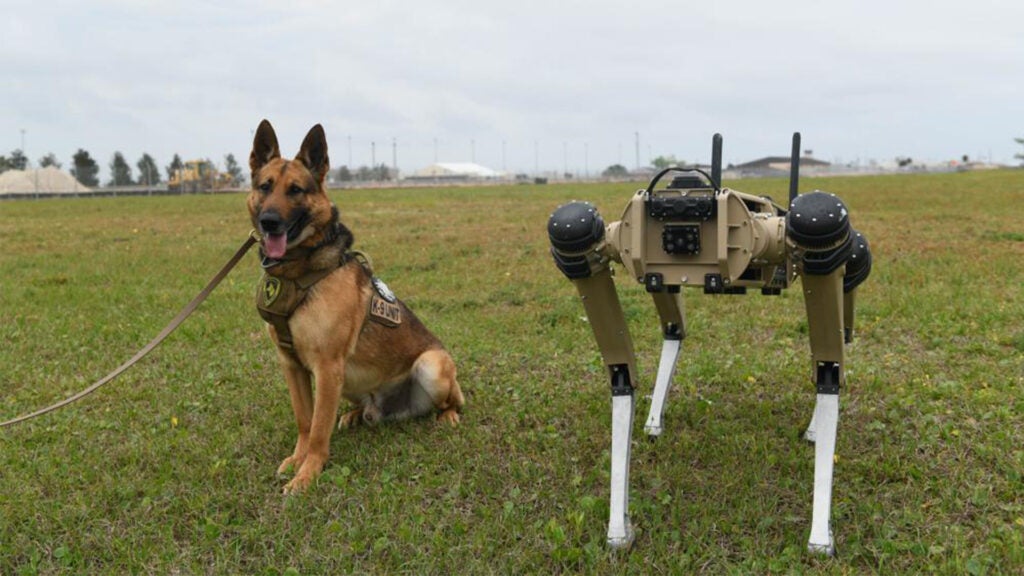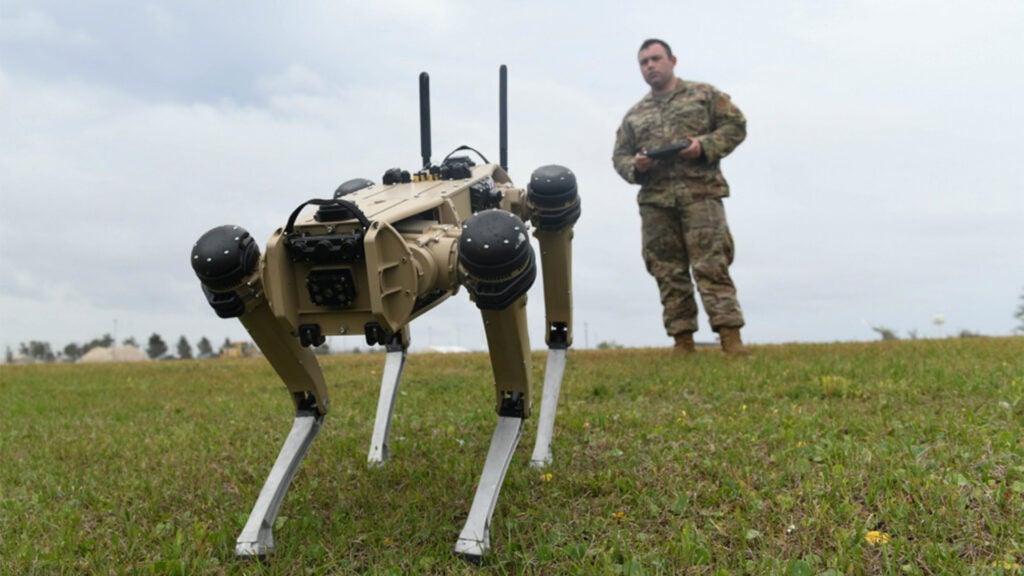When I was 10 or 11, I remember seeing commercials for Tekno the Robotic Puppy on Nickelodeon. The plastic, battery-operated Tekno could walk, bark, and, unlike the useless lumps of golden retriever lying on the floor next to me, use special sensors to respond to commands and toys. Little did I know that, 17 or so years later, I’d be writing about a similar technology that could have profound implications for national security, but here we are.
The Air Force is now fielding semi-autonomous robot dogs that are meant to help human security forces patrol bases and provide eyes and ears in hazardous or remote environments. And while the Quad-legged Unmanned Ground Vehicle may not have a face or a tail, it does have four legs, some fancy-looking antennae, and 14 sensors meant to give it 360-degree situational awareness, all of which the Tekno and my golden retrievers sorely lacked.

The Q-UGVs were delivered to Tyndall Air Force Base, Florida on March 22nd for integration into the 325th Security Forces Squadron, according to a recent Air Force press release. Mark Shackley, the security forces program manager at Tyndall, said the robo-puppers can patrol far-off corners of the base so that their human counterparts can stick to more sensitive areas.
“As a mobile sensor platform, the Q-UGVs will significantly increase situational awareness for defenders,” he said. “They can patrol the remote areas of a base while defenders can continue to patrol and monitor other critical areas of an installation.”

According to an earlier Air Force press release in November, the robot dogs will be given a patrol path that will be set and monitored by a Security Forces Electronic Security Sensor System noncommissioned officer in charge. That allows other security forces airmen to focus on training and overall readiness rather than routine patrols.
“We will be able to drive them via a virtual reality headset within our Base Defense Operations Center,” said Maj. Jordan Criss, 325th Security Forces Squadron commander, at the time. “We will be able to see exactly what the robot dog is detecting through its mobile camera and sensor platform if desired, we will also be able to issue verbal commands to a person or people through a radio attached to the dogs.”
These aren’t some delicate electro-Shih Tzus either. The Q-UGVs can easily navigate difficult terrain (including slippery ice); operate in extreme, -40 degree cold or blistering 131-degree heat; and can be mounted with other sensors and equipment to help on special missions, like explosive ordnance disposal. It is both uncanny and impressive to watch the robot move so naturally. The reason it can do so is because of an “ultra-fast small-footprint reactive controller system that mimics how mammals move over unstructured terrain,” according to the website for Ghost Robotics, which developed the Q-UGV alongside software developer Immersive Wisdom.
At the time of publication, Tyndall public affairs had not answered questions about whether the robot dogs were good boys, whether they enjoyed belly rubs, or whether they would be spayed or neutered. While the Q-UGVs move like dogs and have keen sensors like their canine counterparts, they are not intended to replace the military working dogs that we all love so dearly, the Air Force said. Instead, they will help patrol so that the so-called ‘hoo-mans’ at Tyndall can focus on security roles that require a physical presence, an Air Force official told Task & Purpose.
The robo-woofers are one of many experiments going on at Tyndall, which is in the middle of a sweeping reconstruction process nearly three years after every building on the base, and a few of its F-22 fighter jets, were damaged by Hurricane Michael. Other projects include an overhaul of the flight line area to make room for F-35 fighter jets and possibly MQ-9 reapers; better community common spaces; and new structures that are hurricane-resilient.
“Across the base, every squadron has been pushing the envelope of how we do things and expanding our optics of what is possible,” said Master Sgt. Krystoffer Miller, 325th SFS operations support superintendent. “One huge attraction piece of the robot dogs is that it’s highly mobile and with the amount of construction we will face over the next few years it helps us maintain and increase our security posture.”
If the robo-pooches succeed at Tyndall, it could prompt other bases across the military to adopt the technology.
“I can say that there is definitely a lot of interest in the capabilities of the technology,” said Miller. “I’m hopeful that other units will see some of the successes at Tyndall and will continue to explore the use of non-conventional tactics.”
Related: ‘She’s the best dog in the world’ — Soldier and dog build unbreakable friendship together
The post Air Force robot dogs are here and they appear to be very good boys appeared first on Task & Purpose.
